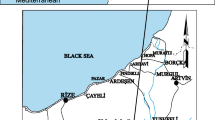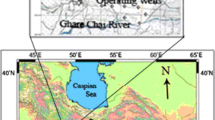Abstract
The Plavinas run-off river scheme in Latvia is founded on fine-grained deposits with artesian aquifers. These aquifers are drained with free flowing wells to assure the stability of the structures. In March 1979, one of these wells suddenly discharged high amounts of solids together with the drainage water. After a few days the water discharge stopped, the artesian pressures in the foundation increased and dirty water flew from the bottom of the tailrace channel area. Foundation failure could be mitigated by turning piezometers into free flowing relief wells. However, it was a critical situation for the powerhouse and caused significant permanent displacements of the concrete structures. A root-cause analysis was performed which is presented in this paper. It was found that caverns at the interface of alluvial and fine-grained deposits formed due to erosion of the fine fractions of the alluvium through the drainage wells. Such a cavern collapsed which caused the well blowout and the plugging of the drainage well resulting in increasing pore water pressures and local liquefaction of the powerhouse foundation.










Similar content being viewed by others
Notes
For concrete dams; for embankment dams the establishment of seepage paths through the structure are equally significant.
The nomenclature “underconsolidated” is used for soil zones where the pore water pressure exceeds the hydrostatic pressure, independent whether this pressure state is induced by loading of low permeable soils or by artesian aquifers.
At this stage one would argue for the installation of more effective filters. This was tried several times already during construction period with numerous different filter designs (see Zaretski and Karabayev 1998) and always led to significant reduced water discharge and hence ineffective drainage.
References
Eberhards G (1972) Geological structure and river valleys development in the River Daugava catchment area. Zinatne, Riga, 132 pp (in Russian)
Finn WDL (1972) Soil dynamics and liquefaction of sand. In: Proceedings of the international conference on microzonation for safer construction: research and application, National Science Foundation, Oct. 30–Nov. 3, Seattle, Washington, United States
II’in VV, Tveritnev VP, Shevlyagin Yu S, Yudkevich AI (2000) Mathematical geofiltration model of the system “soil foundation—hydro installations” for the Plavinas hydroelectric power plant. Powertechnol Eng 34(4):187–192
Messerklinger, S, Straubhaar, R (2011) Filter Design for a High Earth Core Rockfill Dam made of Moraine. In: Schleiss A, Boes R (eds) Proceedings of the 79th ICOLD annual meeting, May 29–June 3, Lucerne, Switzerland, pp 229–238
Messerklinger S, Brenner RP, Dišlere S, Zēgele Z (2009) The long-term behaviour of a run-of-river scheme in Latvia. In: Bauer E, Semprich S, Zenz G (eds) 2nd international conference long term behaviour of dams, Oct. 12–13, Graz, Austria, pp 407–412
Messerklinger S, Brenner RP, Zegele Z (2010) Seasonal fluctuations of the monitoring data of a large powerhouse founded on glacial till. In: 8th ICOLD European Club Symposium, ATCOLD Austrian National Committee on Large Dams, Sept. 22–23, Innsbruck, Austria, pp 577–582
Messerklinger S, Brenner RP, Zegele Z (2011) Long-term seepage behaviour of an embankment dam founded on rock strata under artesian pressure. In: Jinsheng J, Shuguang Z, Zeping X, Yao X (eds) Proceedings of the 3rd international symposium on modern technologies and long-term behavior of dams, Sept. 27–29, Zhengzhou, China, pp 429–438
Šnore (2000) History of incidents in the powerhouse foundation. Unpublished Report. Prepared by the Consulting Company L4, Riga, Latvia
Tveritnev VP, Bourdyukov BA (1998) Plavinas PHPP—remedial measures to ensure safety of structures: results of studies on powerhouse foundation soils. Unpublished report. Prepared for the discussion at the International Experts Panel Meeting, February 1998, Hydroproject, Moscow
Zaretski YK, Karabayev MI (1998) Dam safety improvement report on the survey and research works fulfilled in 1998: book 3: summary note on the system of relief wells at Plavinas HPP. Unpublished report. International Institute of Soil Mechanics and Hydraulic Structures, Moscow
Acknowledgments
The permission of AS Latvenergo to publish this paper is gratefully acknowledged. Linda Berga provided invaluable help in the translation of Latvian and Russian documents. Special thanks go to Dr. R. Peter Brenner for introducing me to the Plavinas site.
Author information
Authors and Affiliations
Corresponding author
Rights and permissions
About this article
Cite this article
Messerklinger, S. Erosion and Drainage Well Blowout in the Foundation of the Plavinas Powerhouse: Case History. Geotech Geol Eng 30, 1421–1433 (2012). https://doi.org/10.1007/s10706-012-9551-0
Received:
Accepted:
Published:
Issue Date:
DOI: https://doi.org/10.1007/s10706-012-9551-0




